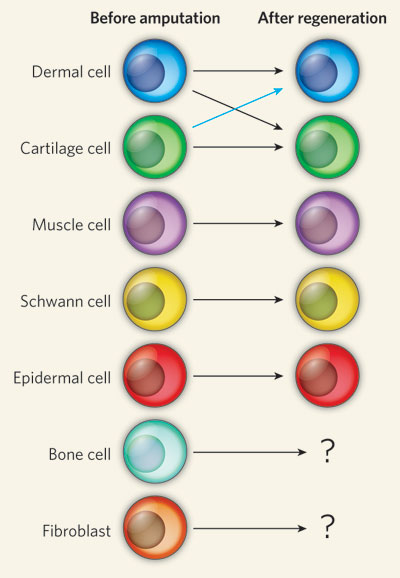
They are the same.
Here is how your brain done this.
We have briefly touched the subject of stem cell research in the last journal club. The challenge of developing “stem cell” as a useful therapy is three fold:
In one sense, the premise of 1 and 2 is that 3 would happen automatically once you can get the Stem cells. They are not only expected to become the desired cell type, but also are expected to know what to do inside the body. This can be a tall order.
There is actually a lot to learn from basic research to see how mother nature deals with the regeneration problem. Salamander is a great regeneration model. If you cut its limb off, the cells in the wound region will grow back a limb to its entirety.
It has long been thought that these cells that are responsible for the regeneration process are pluripotent, or “stem cell”-like. A very interesting research has proven it is otherwise. The original cells in the limb actually remember their identities, and they will only grow back to their own kind. In other words, muscle cells will become muscle cells, and skin cells will become skin cells.

It looks like that instead of having some very specialized stem cells that switch all the way back to the beginning, the differentiated cells just go back a few (?) steps and maintain their identities during the process. One wonders how this process is regulated at the network level and what has been lost in us that we do not have this capability anymore. Maybe this talent is still hibernating somewhere in our genome, waiting for us to turn it back on.
References:
Sánchez Alvarado A. A cellular view of regeneration. Nature. 2009 Jul 2;460(7251):39-40. [PubMed][Nature]
Kragl M, Knapp D, Nacu E, Khattak S, Maden M, Epperlein HH, Tanaka EM. Cells keep a memory of their tissue origin during axolotl limb regeneration. Nature. 2009 Jul 2;460(7251):60-5. [PubMed][Nature]
Please make a recommendation for a funny paper for our lab meeting on 2009-7-28. Please have you recommendation submitted by 2009-7-23 and we will vote on 2009-7-24. NO eye papers please! Be as creative as you can!!
Please make a recommendation for a serious scientific paper for our lab meeting on 2009-7-21. Please make all recommendations by 2009-7-16 and we will vote on which paper to read on 2009-7-17. Get real creative!!!!
may lie inside this girl.
Brooke Greenberg is the size of an infant, with the mental capacity of a toddler. She turned 16 in January.
….
Brooke hasn’t aged in the conventional sense. Dr. Richard Walker of the University of South Florida College of Medicine, in Tampa, says Brooke’s body is not developing as a coordinated unit, but as independent parts that are out of sync. She has never been diagnosed with any known genetic syndrome or chromosomal abnormality that would help explain why.
References:
Doctors Baffled, Intrigued by Girl Who Doesn’t Age [ABC news]
Walker RF. A case study of ‘‘disorganized development’’ and its possible relevance to genetic determinants of aging. Mech Age Devel 2009; 130:350 [PubMed][pdf (link provided by the research group’s site)]
The other day we talked about the historical moment when Matt Meselson and Frank Stahl elucidated the semi-conservative mechanism of DNA replication.
We briefly discussed the challenges that they faced at that time as a graduate student and a postdoc, which I think would give us insights to face our own challenges. I am still reading the longer book about the history behind this experiment. I think it is a very entertaining read but it is also very thick. A shorter historical account published in the PNAS would be easier for many of us to get an overall impression of the story.
References:
Hanawalt PC. Density matters: the semiconservative replication of DNA. Proc Natl Acad Sci U S A. 2004 Dec 28;101(52):17889-94. [PubMed][pdf]
Holmes FL. Meselson, Stahl, and the Replication of DNA: A History of ‘The Most Beautiful Experiment in Biology’ [Amazon]
I read several classic papers when I am planning projects with some of you. This is a very good review paper on the fundamental architecture of retina. There are a lot useful histological facts and observations. It has great discussions on how the retinal architecture has evolved and in turn provides the necessary visual functions to the animal. I believe you will also find this review paper useful.
Reference
Masland RH. The fundamental plan of the retina. Nat Neurosci. 2001 Sep;4(9):877-86.[PubMed][Nat Neurosci]
This is a series of papers from a recent Sackler colloquium of the National Academy of Sciences entitled “In the Light of Evolution III: Two Centuries of Darwin“. You can watch most of the presentations online here. The conference papers are published in a supplemental issue of the PNAS.
I read Daniel Dennett‘s paper because of my personal interest. He is a philosopher in science. In his paper, he provides a simple overview on why it is not necessary to have an intelligent designer to make complicated biological machines.
Reference
Dennett D. Darwin’s “strange inversion of reasoning”. Proc Natl Acad Sci U S A. 2009 Jun 15. [PubMed][pdf]
Please suggest your favorite paper by making a comment here. Once everyone has made a suggestion, we will vote for it. Let’s decide by this Thursday 6/25.
Thanks!